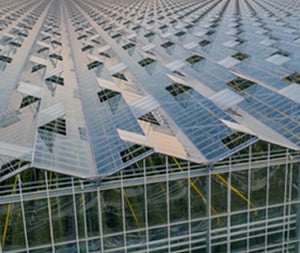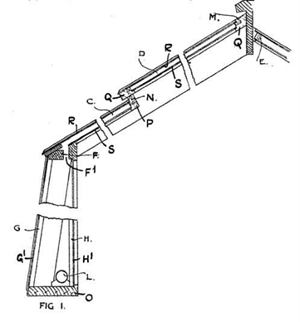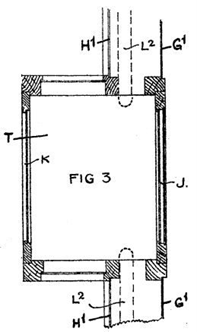Historical horticultural patents: double glazing in greenhouses
 Saving energy - this is very topical right now because of high energy prices but also a real challenge for greenhouses. One of my first thoughts was why don’t they use a lot more double-layer insulating glass in greenhouses? After all, the more layers of glass the better the insulating value. Unfortunately it is not quite as straightforward as it seems.
Saving energy - this is very topical right now because of high energy prices but also a real challenge for greenhouses. One of my first thoughts was why don’t they use a lot more double-layer insulating glass in greenhouses? After all, the more layers of glass the better the insulating value. Unfortunately it is not quite as straightforward as it seems.
Cavity heating
In 1929 Albert Oliver Blatchford applied for patent GB-344.963 for double-glazing with cavity heating for greenhouses. He placed a heating pipe L at the bottom of the space between glass layers G-H of the greenhouse walls. In addition he provided a connection channel F1-N to the spaces between glass layers R and S of the greenhouse roof.
And it didn't stop there. He had even considered placing a heated vestibule in the heated double-glazing structure. You can see this in the top-down view in Fig. 3 which shows doors J and K with the vestibule T between them.
So what is the point of having this?
The big question is: why did he come up with this idea? When we look at this from a 2022 perspective, we immediately think to save energy! These days we use double glazing mainly for insulation. It creates a trapped layer of air between the glass. Because this layer of air does not circulate it conducts heat very poorly. This is how you insulate.
However, Albert's double-glazing structure did not lead to major energy savings but then again that was not really what he aimed to achieve. Instead, he wanted to ensure that the heat would spread over a large area around the plants.
Light transmission
To keep the heat inside a greenhouse, double glazing is now also widely considered as an alternative to closing energy screens under the greenhouse roof. In this case, however, care should be taken to avoid negatively affecting light transmission. After all, more light often means higher crop yields. In the case of double-layer insulating glass, deterioration in light transmission can be overcome by applying a suitable solar coating to the glass, such as an anti-reflective coating. This can then give the double-layer insulating glass a comparable transmission to standard single-glazing with an added advantage.
Weight
However, double-layer insulating glass is still twice as heavy as standard single-glazing. From 10kg to 20kg per m2. This has implications for the structure of the greenhouse roof, which is something that can be taken into account in new build greenhouses. For retrofit insulation in existing greenhouses this is a great deal more problematic. It could be overcome, for instance, by using thinner glass, such as ultra-thin glass as used in mobile phones, which is only 0.5mm thick. By comparison, standard glass is 4mm thick. In other words, the use of double-layer ultra-thin glass could give a weight saving of factor 4, and it even makes it possible to use triple or even quadruple layer ultra-thin glass. However, a solution still needs to be found when it comes to deflection and maintaining the load-bearing capacity.
Dehumidification
Increasing greenhouse insulation by using multilayer insulating glass also means that you have to take measures to remove additional moisture. However, a dehumidification unit also uses energy, and a lot of heat can soon be lost to the outside air. The use of a balanced ventilation system with heat recovery can provide a solution here.
Snow
In countries with harsh winters, snow load is a factor to consider. A high degree of insulation complicates the melting of snow. The greenhouse roof could collapse under the snow load and on top of that the snow will block a lot of light. Switchable cavity heating of the space between the glass layers could provide a solution when it comes to ensuring that the snow on the greenhouse roof melts immediately when it snows. And that completes the circle, because when it comes to double-layer glass structures with cavity heating, we are back to Albert Oliver Blatchford. Credit where credit is due.
Challenge
Readers who know me a little better will know that I have a tendency to challenge you to improve and innovate. So I like to be surprised: are you working on innovative ways to save energy in greenhouses? They could be with or without double glazing, of course, and hopefully something completely new. If so, please let me know. I will gladly devote a future blog to it - after the patent application has been filed of course!

About the author
Since joining EP&C in 1994, I’ve enjoyed working with passionate inventors across a broad range of technologies. My background in mechanical engineering equips me to analyze innovations down to their...
More about Rudi >
